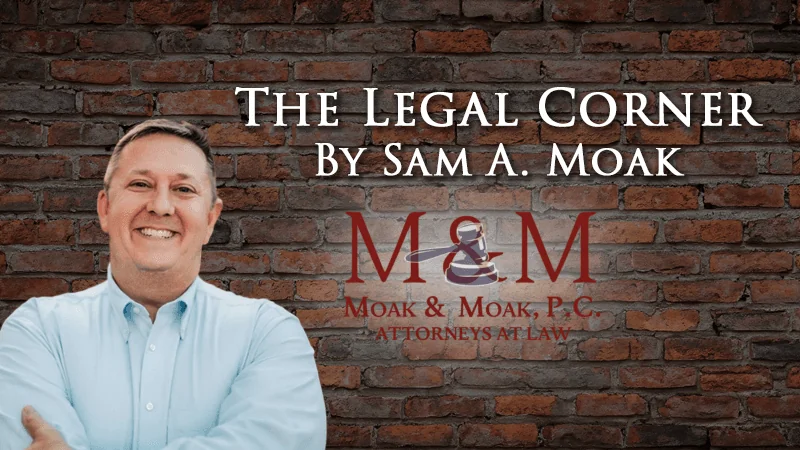The information in this column is not intended as legal advice but to provide a general understanding of the law. Any readers with a legal problem, including those whose questions are addressed here, should consult an attorney for advice on their particular circumstances.
Occasionally, I am approached by someone who wants to convey property by an Assumption. An Assumption is a means by which a Buyer may assume or take over the mortgage of the Seller. The parties will exchange an Assumption Deed which provides the Buyer title to the property with the requirement to make the Seller’s mortgage payments.
Caution should be used when entering such transactions. This is because the Seller’s Deed of Trust, signed with the original lender, usually contains a provision that the mortgage may not be assumed or any interest in the property transferred without written consent from the lender. Failure to secure this consent subjects the entire balance of the amount owed to be due immediately. Additionally, if the Buyer fails to make the payments as promised, it could adversely affect the seller’s credit because the seller remains responsible for payment of the note.
Another option may be to seller finance the exchange. Seller financing is a means by which the current owner of the property acts as the lender or bank for the purchaser. This is a common form of financing the sale of property. Some of the reasons you may want to consider Seller financing are:
1) The deal may close faster;
2) Your buyer does not want to deal with a third party lender because of the fees;
3) As a form of investment for the Seller;
4) Your Buyer does not have an extensive credit history; or
5) Perhaps your Buyer has a bad credit history.
If you seller financing the transaction, and you are still paying on a note yourself, you should obtain written permission from the lender before selling the property. Remember that just the transfer of interest or sale of the property may trigger the original note to become immediately due and payable.
If your Buyer approaches you about Seller financing, there are at least two things you should do to protect yourself:
1) Ask for a credit report; and,
2) Ask for references.
If your potential Buyer has a bad credit history there is a reason. You must ask yourself if you want to take the risk that you may have to deal with (1) late, partial or missed payments; (2) proceeding without a substantial down payment; or, (3) if the Buyer defaults, having to deal with recovering your property.
Knowing a person’s credit history and how they allocate their paycheck each month will give you an idea of their priorities. When it comes to their choosing which bill to pay, you do not want to be on the short end of the stick.
The most common form of Seller financing is through the use of a Warranty Deed with Vendor’s Lien, Real Estate Lien Note, and Deed of Trust. These are the same instruments used by the lender or bank when third party financing is used.
By signing a Note, the Buyer is promising to pay a certain amount for the property. The note amount is listed as well as the amount of interest they will pay. Normally, the interest is negotiated just like the sales price. Because the Seller is not in the business of loaning money and is not accustomed to the risks associated with loaning money, the interest rate on Seller financed deals is usually higher than for third party financing.
A Deed of Trust is an instrument filed for record at the courthouse which reflects that a Note has been signed for the purchase of the described real property. The Deed of Trust serves to put the public on notice that the property is being purchased by the Buyer subject to a debt being paid, and until the debt is paid, a lien exist against the property. The Deed of Trust serves as the agreement between the Seller and Buyer and sets out the conditions each party must comply with for the sale. The Deed of Trust also should provide the Seller with the right to accelerate the debt owed if the Buyer fails to make the payments as agreed. This means that if the Buyer is late in making a payment, the Seller has the right to demand the full amount of the Note, after proper notice and opportunity to cure default.
The Warranty Deed with Vendor’s Lien signifies that the Buyer is the record owner of the property subject to the Seller’s lien on the property. Once the debt is paid a Release of Lien is filed, making the deed “absolute.” No new deed is required, because the Warranty Deed with Vendor’s Lien is the Buyer’s deed and the Release of Lien signifies the lien placed on the property by the Note and Deed of Trust has been paid.
Under this form of Seller financing, if the Buyer fails to perform all the requirements under the Note and Deed of Trust, then the Seller must foreclose on the property to regain it. Foreclosing on property requires filling a notice of foreclosure and providing the Buyer with a designated number of days within which to cure the default. If the Buyer cures the default and pays the cost associated with filing the foreclosure, then they retain the property and continue to make payments. If they do not, the property is sold at a Trustee’s Sale.
Because of the legal formalities involved, you should consult an attorney when deciding to Seller finance your home or property. Seller financing the sale may allow the deal to happen faster, but you must decide if this advantage outweighs the risks and if the legal documents provide you the best protection under the law.
Sam A. Moak is an attorney with the Huntsville law firm of Moak & Moak, P.C. He is licensed to practice in all fields of law by the Supreme Court of Texas, is a Member of the State Bar College, and is a member of the Real Estate, Probate and Trust Law Section of the State Bar of Texas.www.moakandmoak.com©


